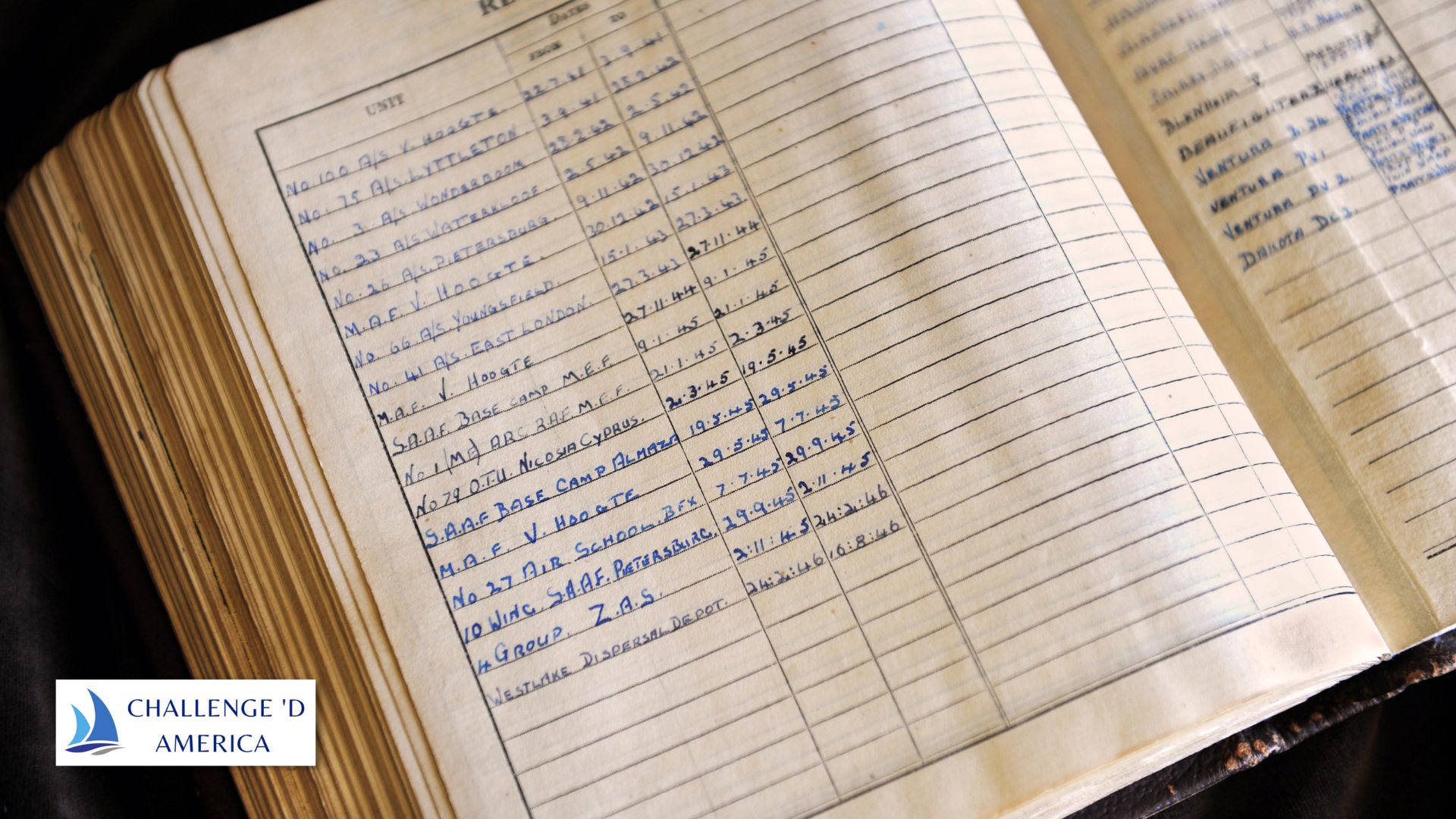All About Sailing Log Book / Captain’S Log | How To Keep
Welcome to my sailing blog! I’m here to tell you all about sailing log books and the importance of keeping one.
Whether you’re an experienced sailor or a beginner, a sailing log book is an essential tool for monitoring and recording your progress, and it can help you take your sailing to the next level.
In this article, I’ll explain the basics of sailing log books, why they’re so important, and how to keep one. So, let’s get started!
What is a Captain’s Log?
As a sailor, it’s important to document your sailing experiences and share them with other sailors or boating enthusiasts. This is where the captain’s log comes into play.
A captain’s log is an important record of a captain’s journey, including details of the vessel’s progress, sailing conditions, and any problems encountered during the voyage.
It is also a great way to document the places you have visited and the people you have met along the way.
By keeping a captain’s log, you can look back on your sailing adventures with the same sense of pride and accomplishment that inspired you to set sail in the first place.
Digital VS. Paper Captain’s Log
When it comes to keeping a captain’s log, there is a debate between digital and paper logs. While many sailors prefer the traditional paper log, digital logs are becoming increasingly popular.
One advantage of a digital log is that it can be easily accessed and stored. This makes it easier to find the information if it needs to be shared with another sailor or referred back to in the future.
Digital logs also have the added benefit of being able to be shared in real-time, which can be helpful for tracking long trips or emergencies.
On the other hand, paper logs are still favored by some sailors for their traditional feel and ability to record details manually.
There is also the advantage of being able to write down detailed notes or draw diagrams that can be referred back to in the future.
Ultimately, the choice between digital and paper logs comes down to personal preference. While there are advantages and disadvantages to both types of logs, it is important to find a system that works for you and your crew.
Benefits of Keeping a Captain’s Log
As a sailor, keeping a captain’s log provides a number of valuable benefits. Firstly, it allows you to track the progress of your journey.
By noting the coordinates of your vessel, you can easily compare the start and end points of your journey, and keep track of the miles you’ve traveled.
Additionally, you can record the weather conditions and any notable sightings you may have seen along the way.
Secondly, it allows you to document your experiences for future reference. By taking regular notes of your journey, you can look back and reflect on your experiences and accomplishments.
This can be a great source of motivation when you look back on your adventures, and can help you to plan for future trips.
Finally, a captain’s log serves as an invaluable document for insurance claims and legal matters. By having a written record of your journey, you can easily prove the validity of your voyage, helping to protect you if any disputes arise.
Overall, keeping a captain’s log is an essential part of any sailing journey, and provides you with a number of valuable benefits.
Whether you’re an experienced sailor or a beginner, having a log can provide you with a detailed record of your journey, and ensure your safety both on and off the water.
What to Record in the Captain’s Log
As the captain of a sailing vessel, it is important to keep a detailed log to document your journey. There are a number of items that should be recorded in the captain’s log, from location and weather to maintenance and repairs.
Here are some of the key elements to consider when keeping a captain’s log:
• Date, Time & Location: Log the date, time and exact location of your vessel as you sail. This information can be used for navigation purposes as well as to provide a timeline for your journey.
• Weather: Record the weather conditions you encounter, such as wind speed, temperature and cloud cover.
• Visits: Note any port visits and the people you meet such as harbormasters, customs officers and other sailors.
• Maintenance & Repairs: Keep track of any maintenance and repairs that are performed on the boat. This can be helpful in the future when evaluating the performance of your vessel.
• Observations & Notes: Use the captain’s log to jot down any noteworthy observations or notes about your journey.
By keeping a detailed captain’s log, you can ensure that your journey is well documented and that you have a record to refer back to in the future.
How To Fill Out A Sailing Log Accurately
When sailing, it’s important to keep an accurate record of your journey. A sailing log book, also known as a captain’s log, is an essential tool for recording the details of your voyage. Whether you’re a beginner or a seasoned sailor, here’s how to fill out your sailing log accurately.
Start with the basics. When you begin a new log entry, start by noting the date, time and location. Include the weather conditions, wind speed and direction, and the type of craft you’re using.
Next, include any maintenance activities. Note any repairs or adjustments that you make to the vessel, or any supplies you take on board.
Then, document any changes in the crew. List who is on board, and the dates when crew members come and go.
Finally, don’t forget to include any notes from your voyage. This could include any incidents or events, or any interesting sightings.
By taking the time to fill out your sailing log accurately, you can ensure that you have a detailed record of all your voyages. This can help you track your progress as a sailor, and provide you with a permanent record of your journeys.
Do You Need A Captain’S Log If You Use A Gps?
If you have a GPS on board your vessel, you may be wondering if you still need to keep a Captain’s Log. The simple answer is yes. A GPS can help you navigate the seas, but it doesn’t replace the need for a Captain’s Log.
A Captain’s Log is a detailed record of the boat’s voyage and includes information such as the route taken, the weather, the conditions of the sea, the crew’s activities, any medical issues, and any unexpected events or incidents. This information is invaluable in the event of an emergency or a legal dispute.
GPS tracking devices can provide some information about a boat’s whereabouts but they can’t provide the same level of detail as a Captain’s Log.
A GPS won’t tell you about the crew’s activities, the weather, the conditions of the sea, or any medical issues.
A Captain’s Log is also a great way to document and remember the memories of your sailing trips. The log book is a physical reminder of the places you’ve been, the people you’ve met, and the experiences you’ve had.
So, if you’re sailing with a GPS, you still need to keep a Captain’s Log. It’s the only way to ensure that your voyage is documented properly.
Where To Buy A Captain’S Log
For those looking to purchase a Captain’s Log, there is a wide variety of options available. In addition to traditional nautical stores, many online retailers now offer a range of Captain’s Logs.
Some of the most popular brands include:
• Sea-Dog: Sea-Dog Captain’s Logs come in a variety of sizes and styles, making them perfect for any sailor. They feature waterproof, tear-resistant paper and come with a pen loop for easy storage.
• Weems & Plath: Weems & Plath offer a range of traditional and modern Captain’s Logs. These Logs are designed to last, with waterproof, acid-free paper and hardbound covers.
• CS Yachts: CS Yachts offer a wide range of Captain’s Logs for powerboats and sailboats. These logs feature large, easy-to-read pages and come with a handy pocket for storing notes and other items.
No matter which Captain’s Log you choose, make sure that it meets your needs and allows you to keep a detailed record of your sailing trips. Keeping an accurate log is an important part of any successful sailing journey.
Tips For Choosing A Captain’S Log
As an experienced sailor, I know that selecting the right captain’s log is essential for documenting your voyages.
Here are a few tips to help you make the best choice when it comes to choosing a captain’s log:
1. Consider Your Needs: Think about the type of information you would like to record in your captain’s log. Do you need a log that is specifically designed for sailing or would a general-purpose log be sufficient?
2. Check the Quality: Make sure to check the quality of the log book before you purchase it. Look for a log that is made of durable materials and features a waterproof cover.
3. Look for Features: Some captain’s logs come with additional features, such as a built-in calculator, weather charts, or a GPS function. If any of these features are important to you, make sure to look for them when shopping for a log.
By following these tips, you can be sure to select the right captain’s log to help you document your sailing adventures.
Tips For Filling Out A Captain’S Log
As an experienced sailor, I recommend that captains take the time to routinely fill out their logbook and keep it up to date. While it can seem like a tedious task, there are a few tips that can help make it easy and efficient.
First, make sure to always include the date and the location for each entry. This is the most important part of any logbook entry, and should always be filled out accurately and in detail.
Second, make sure to include any weather information that may be relevant. This includes the wind speed and direction, air temperature, and any other meteorological conditions that may have had an impact on the voyage.
Third, be sure to include any observations about the vessel and its performance. For example, if you noticed any unusual behavior, or if the vessel performed better or worse than expected, make sure to document it.
Finally, make sure to include any other relevant information, such as the number of passengers, crew, and cargo on board, and any other relevant details that may be helpful in the future.
By following these tips and taking the time to fill out your captain’s logbook, you’ll be well-prepared to keep a detailed record of your sailing voyage.
Alternatives To A Captain’S Log
For sailors who prefer something other than a traditional captain’s log, there are a few alternatives options available. One is to use a chart recorder which is a device that automatically records and stores data such as wind speed, wind direction, temperature, and other pertinent sailing information.
This data can then be uploaded to a computer where it can be analyzed and used to help plan a course or evaluate performance.
Another option is to use a sailing journal. This is a dedicated book, often leather bound, that can be filled with details about individual trips, as well as sailing accomplishments and challenges.
It’s a great way to document and remember a sailing journey, and it can be used to help with future planning.
Finally, modern technology has also enabled the use of digital logbooks. These are apps or programs that allow sailors to record and store data from their trips, such as weather conditions, course changes, and sailing accomplishments.
Not only are digital logbooks an efficient way to store data, but they can also be used to share information with other sailors.
Is A Ship Log A Legal Requirement?
As a sailing enthusiast, you may have wondered if keeping a ship log is a legal requirement. The short answer is that it depends on the type of sailing you are doing.
For recreational sailing, there is no legal requirement to keep a ship log, although it is highly recommended. However, if you are a professional sailor or renting a boat, then you may be legally required to keep a ship log.
Most states require commercial boat operators to keep a log of their voyage, detailing the location, time, and any other pertinent information. In addition, many countries have regulations regarding the types of information that must be kept in a ship log.
If you are a professional sailor, it is important to check with your local and national laws to make sure you are in compliance with the regulations.
Additionally, if you are renting a boat, be sure to ask the owner if you need to keep a ship log when you sign your rental agreement.
Keeping a ship log is an important part of sailing safety, so it is important for all sailors to be aware of the laws and regulations regarding ship logs.
How Do You Keep Track Of Boat Hours?
As a sailor, it’s important to keep track of the hours your boat is in use. You should log the number of hours your boat is in use, as well as the conditions it is being used in.
This will help you track the maintenance schedule of your boat, as well as let you know how much time you’ve spent on the water.
The best way to track boat hours is to keep a sailing log book, or captain’s log. This is a written record of the boat’s hours and any pertinent information.
You should log the dates and times when the boat is used, as well as any weather conditions and other details. This will help you stay organized and give you a record of the boat’s usage.
It’s also a good idea to keep an electronic log book. This can be done on your smartphone or tablet, and can be an easy way to track your boat’s hours. It’s important to remember to back up your electronic logs, in case the device is ever lost or damaged.
By keeping track of your boat’s hours, you can ensure your boat is properly maintained and monitored.
Not only will this help you stay organized and better manage your boat, but it can also be a great safety measure.
By keeping track of the boat’s hours, you’ll be able to identify any potential issues or safety concerns before they become a bigger problem.
What Should Be Recorded In A Log Book?
As a sailor, it is important to keep a log book of your trips and journeys. Not only is this necessary to document your travels, but it is also a great way to keep track of your experience, adventures, and learning. So, what should you record in your log book?
First, always include the date, time, and location of your voyage. This will help you to remember where you have been and keep a timeline of your trips.
Additionally, include any significant events that occurred during the voyage. This can include weather, wildlife sightings, incidents that happened, and any other noteworthy events.
It is also important to record any maintenance or repairs that were done on the boat. This is a great way to keep track of the boat’s condition and ensure that it is running in top shape.
Lastly, log any changes in crew, passengers, or equipment that occur over the course of the voyage.
By keeping a comprehensive log book, you can ensure that you are getting the most out of your sailing experience. It will also help you to look back on your adventures and remember all the wonderful things you have done.
What is the Purpose of a Captain’s Log in Coding?
As a sailor and coding enthusiast, I have long been a proponent of utilizing a captain’s log when coding. This log is a vital tool for keeping track of your coding progress and for troubleshooting any issues that may arise. It is a way to organize your thoughts and ensure that your coding efforts are successful.
A captain’s log should be used to document any changes to the code base, any new features added, any bugs that have been identified, and any other notes that are relevant to the project.
By keeping a log of your coding progress, you can easily identify any issues that may have arisen, and can quickly remedy them.
Additionally, a captain’s log is a great way to analyze trends in the codebase, and to ensure that the codebase is regularly updated and maintained.
This is especially important when working on large projects, as it allows you to accurately track your progress and quickly identify any potential issues.
Ultimately, a captain’s log is an invaluable tool for coding, and I highly recommend that all coders utilize one to ensure that their projects are successful.
How Much Does A Captains Logbook Sell For?
As a sailing enthusiast, you may be wondering how much a captain’s logbook will cost. The answer to this question depends on the type of logbook you are looking for.
Generally speaking, basic logbooks can be purchased for as little as $10, while more detailed logbooks with added features can cost upwards of $50 or more.
When shopping for a captain’s logbook, it is important to consider the features that are most important to you.
If you are simply looking for a basic logbook to track your sailing trips, then you can opt for a more budget-friendly option.
However, if you are looking for a logbook that offers more detailed information on each trip, such as wind speed, position, and other vital data, then you will need to invest in a more expensive logbook.
No matter what type of logbook you are looking for, it is important to remember that investing in a quality logbook is an investment in your sailing experience.
A well-made logbook can be a valuable tool for tracking your sailing trips, and can provide you with a wealth of information on each voyage.
All About Sailing Log Book / Captain’S Log | How To Keep
In conclusion, keeping a log book or captain’s log is essential for any sailor. It is an invaluable tool for tracking information such as weather, sea conditions, navigation, repairs and maintenance, and more.
It can also serve as an important reference for future sailing trips. By keeping a regular log, sailors will be able to review their past experiences and make more informed decisions in the future.
As Gary Jobson, a professional sailor, I strongly advise all sailors to take the time to maintain a log book or captain’s log. It is the best way to ensure a safe and enjoyable sailing experience.







